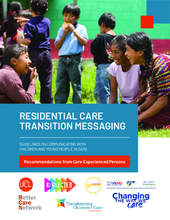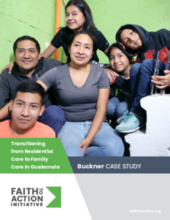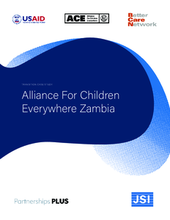The aim of this stage is to introduce the concept of transition to all remaining relevant stakeholders and create opportunities for discussion and for participation. Stakeholders include staff, children, families, Care Leavers, local authorities and community leaders and may also include other donors or individual supporters or child sponsors.
Messages need to be tailored to each group of stakeholders based on their differing roles, perspectives and the impact transition will have on them and address concerns they are most likely to raise. The communications strategy should factor in decisions such as the order in which stakeholder groups should be informed and consulted and the timeframe for implementing the communications plan.
This stage is concerned with communication, securing participation from the relevant stakeholders, and alleviating initial concerns that naturally arise when change is introduced.
Activities that may occur during this stage include:
- Developing and implementing communications and messaging plans for:
- Staff of the institution- outlining the reasons for transition, the process, the timeframe, the changes to their roles and responsibilities, expectations and concrete options for upskilling or job security post transition. This should also cover guidance on staff communication with children about transition to ensure children’s perspectives are not negatively influenced by any staff/caregiver concerns nor reintegration used as a threat or presented as a punishment for ‘misbehaving’ children.
- Children and young people in the institution- participatory and child friendly communication that gives children and young people an understanding of what’s going to happen, why (positive framing), how they will be involved, how their views will be sought and factored in, timeframes, what changes are they likely to see or experience in the meantime, how their best interests will be protected, and how they will be supported once reintegrated. This needs to be followed up with numerous opportunities to consult with children, hear their views, address their concerns. Child and youth consultation could take place in groups, and where more appropriate, one on one. At this stage discussions should be more generalized and focused on the processes rather than placements for individual children. Placement related discussions should occur as part of the care planning stage. Consultation with children and young people should be approached thoughtfully and cautiously to avoid causing distress or harm, especially if there is uncertainty in their individual care plans at this stage.
- Families of children in the institution- outlining the benefits of transition, the process for reintegration, the timeframe for outworking the process, the right of families to participate in placement decisions and the development of child and family support plans, what type and level of support that will be made available to families and how those decisions will be made. Initial meetings with families may occur in a group or one on one. Follow up discussions need to take place with individual families to address concerns and questions, provide reassurance and to discuss how transition is discussed with children. As with children and young people, discussions at this stage are general and focused on the process rather than individual placement decisions. Discussions about individual placements happen in the care planning stage.
- Care Leavers who continued to be supported by the institution and/or have siblings in care- outline the reasons for transition being careful to avoid labelling or stereotyping, provide information on the process, particularly for those with siblings still in care, discuss the impact on Care Leaver support and outline what process will be put in place for reviewing and adjust support levels in consultation with the young person, if necessary.
- Community leaders- engage with relevant leaders in the children’s communities of origin and/or the community surrounding the institution. This may include local government, religious leaders, elders or other influential figures. Communicate the reason for transition, outline the process, and discuss with community leaders the types of support they might be able to provide to children reintegrating, including to reduce stigma and ensure children are welcomed and their families supported.
- Donors/sponsors- prepare positive messaging outlining the change and benefits to children, the positive progress reintegration represents, and the ways transition will further the organization’s mission/objectives.
- Developing and putting into place child friendly communication mechanisms to give children/youth opportunities to continue to express any concerns they have, ask questions, or provide ideas and inputs into the transition process. These can be communication boxes, question boards, sessions with counsellors or social workers.
- Holding one on one or small group conversations with staff after the plans to transition have been communicated. This provides opportunities to discuss staff roles and job security, and can be an important means of preventing fear, confusion, anger, or uncertainty leading to any form of intentional or unintentional sabotage.
- Evaluating the stakeholder communications and engagement activities and capturing learning from this stage. Consider involving stakeholders in evaluation efforts.
The key milestones associated with this step are:
- All stakeholders have an opportunity to share their Initial views and perspectives on transition.
- Stakeholder’s immediate concerns are addressed and there is a mechanism in place for further questions to be raised and addressed.
- Child friendly communication and participation mechanism are put in place and children/young people are informed of how they can use them.
- Stakeholders understand the process moving forward and importantly the timeline for transition.
- Stakeholder cooperation (particularly staff) is secured, and staff feel confident about their roles in and beyond the transition.
Resources
Displaying 1 - 9 of 9
Resistance from donors is a common barrier for organizations transitioning from residential care to family-based care. What works to sustain and even increase funding for organizations in transition?
The purpose of these guidelines is to support practitioners to develop messaging for children and young people that clearly communicates the intention to transition and the implications for children and young people in care. The guidelines seek to address challenges so that children and young people can fully understand the implications of transition and be granted opportunities to genuinely and appropriately participate in making decisions about their lives.
The story of Heartline’s transition from residential care to family care is told in this recently released Faith to Action case study. The case study details their experience through three stages of transition—learning, preparation and planning, and full transition—with transparency. It addresses common challenges for transitioning organizations, as well as the strategies Heartline took to overcome them.
The story of Buckner Guatemala’s transition from residential care to family care is told in this recently released Faith to Action case study. The case study details their experience through three stages of transition—learning, preparation and planning, and full transition—with transparency. It addresses common challenges for transitioning organizations, as well as the strategies Buckner took to overcome them.
This study was designed to be a small insights-based qualitative learning and reflection study to explore catalysts for transition. It was based on interviews conducted with Charitable Children’s Institutions’ (CCI) directors that sought to identify and explore the range of factors that influenced each director’s decision to transition their residential care services, and the interplay between those factors.
Alliance for Children Everywhere (ACE) Zambia is a US-funded organization that transitioned from providing residential care in Zambia to pioneering family-based care, including foster care, and supporting other residential care service providers to transition. With important links to the Zambian government, ACE Zambia has been a key actor in supporting the development of policies, programs and guidelines that are now utilized across the country.
This case story is meant to illustrate transition, the actors involved, the challenges and the success factors; recognizing that each transition is an individual process with different starting points, different dynamics and different evolutions.
In this two-part video series, Nou Dalin, part of the social work team with Cambodia Children's Trust (CCT), discusses her experience of working in partnership with the Department of Social Affairs, Veterans and Youth Rehabilitation (DoSVY) to implement the Ministry of Social Affairs, Veterans and Youth Rehabilitation (MoSVY) Action Plan on Improving Childcare in Battambang Province in Cambodia.
The aim of this book is to explain to children what to expect during the time the institution in which they reside is closing.







